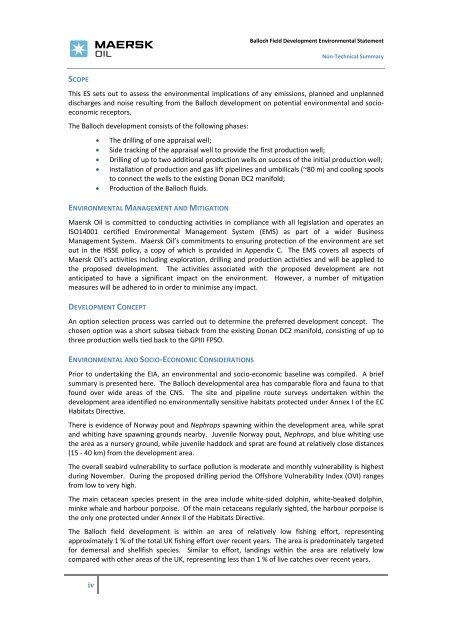Environmental Statement - Maersk Oil
Environmental Statement - Maersk Oil
Environmental Statement - Maersk Oil
You also want an ePaper? Increase the reach of your titles
YUMPU automatically turns print PDFs into web optimized ePapers that Google loves.
SCOPE<br />
iv<br />
Balloch Field Development <strong>Environmental</strong> <strong>Statement</strong><br />
Non‐Technical Summary<br />
This ES sets out to assess the environmental implications of any emissions, planned and unplanned<br />
discharges and noise resulting from the Balloch development on potential environmental and socio‐<br />
economic receptors.<br />
The Balloch development consists of the following phases:<br />
The drilling of one appraisal well;<br />
Side tracking of the appraisal well to provide the first production well;<br />
Drilling of up to two additional production wells on success of the initial production well;<br />
Installation of production and gas lift pipelines and umbilicals (~80 m) and cooling spools<br />
to connect the wells to the existing Donan DC2 manifold;<br />
Production of the Balloch fluids.<br />
ENVIRONMENTAL MANAGEMENT AND MITIGATION<br />
<strong>Maersk</strong> <strong>Oil</strong> is committed to conducting activities in compliance with all legislation and operates an<br />
ISO14001 certified <strong>Environmental</strong> Management System (EMS) as part of a wider Business<br />
Management System. <strong>Maersk</strong> <strong>Oil</strong>’s commitments to ensuring protection of the environment are set<br />
out in the HSSE policy, a copy of which is provided in Appendix C. The EMS covers all aspects of<br />
<strong>Maersk</strong> <strong>Oil</strong>’s activities including exploration, drilling and production activities and will be applied to<br />
the proposed development. The activities associated with the proposed development are not<br />
anticipated to have a significant impact on the environment. However, a number of mitigation<br />
measures will be adhered to in order to minimise any impact.<br />
DEVELOPMENT CONCEPT<br />
An option selection process was carried out to determine the preferred development concept. The<br />
chosen option was a short subsea tieback from the existing Donan DC2 manifold, consisting of up to<br />
three production wells tied back to the GPIII FPSO.<br />
ENVIRONMENTAL AND SOCIO‐ECONOMIC CONSIDERATIONS<br />
Prior to undertaking the EIA, an environmental and socio‐economic baseline was compiled. A brief<br />
summary is presented here. The Balloch developmental area has comparable flora and fauna to that<br />
found over wide areas of the CNS. The site and pipeline route surveys undertaken within the<br />
development area identified no environmentally sensitive habitats protected under Annex I of the EC<br />
Habitats Directive.<br />
There is evidence of Norway pout and Nephrops spawning within the development area, while sprat<br />
and whiting have spawning grounds nearby. Juvenile Norway pout, Nephrops, and blue whiting use<br />
the area as a nursery ground, while juvenile haddock and sprat are found at relatively close distances<br />
(15 ‐ 40 km) from the development area.<br />
The overall seabird vulnerability to surface pollution is moderate and monthly vulnerability is highest<br />
during November. During the proposed drilling period the Offshore Vulnerability Index (OVI) ranges<br />
from low to very high.<br />
The main cetacean species present in the area include white‐sided dolphin, white‐beaked dolphin,<br />
minke whale and harbour porpoise. Of the main cetaceans regularly sighted, the harbour porpoise is<br />
the only one protected under Annex II of the Habitats Directive.<br />
The Balloch field development is within an area of relatively low fishing effort, representing<br />
approximately 1 % of the total UK fishing effort over recent years. The area is predominately targeted<br />
for demersal and shellfish species. Similar to effort, landings within the area are relatively low<br />
compared with other areas of the UK, representing less than 1 % of live catches over recent years.








